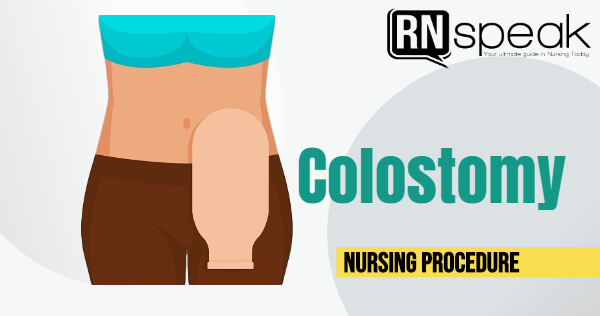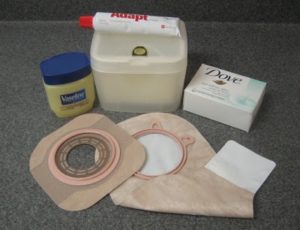Ostomies are performed on patients who have conditions that require surgically created openings to aid in elimination. These conditions include the presence of masses and tumors, necrotic tissues, and gastrointestinal tract strictures. The opening of the ostomies that are located and accessible outside of the body are called stomas.
Stomas usually protrude above the skin’s surface by a few millimeters, sometimes looking slightly edematous, moist, and pinkish to reddish color. While it may appear like an open wound, these stomas are not painful since no nerve endings are located on their edges. Moreover, ostomies become accessible outside the body through appliance where pouches may be attached to collect the output. This output is called the effluent.
Ostomies are created in several parts of the body and are called in reference to its location. Colostomies, the most common of all, are created from a part of the colon to help divert fecal matter from the anus and into an opening outside of the body.
This is usually done among patients who suffer from obstructions in the colon, trauma related to injuries or a complication of surgical procedures, or as a result of other diseases processes in the gastrointestinal tract. Other forms of ostomies, such as ileostomy, helps divert fecal matter from the ileum, while a urostomy (sometimes called an ileal conduit) is created using a portion of the intestines to help divert urine outside the body when there are problems in the urinary tract.
Because of the nature of these openings, ostomies are sometimes being done only on a temporary basis while the patient undergoes treatment for the underlying problem. The presence of colostomies places the patient at increased risk of suffering from complications such as fluid and electrolyte imbalances due to loss of body fluids, infections, and even body image changes. While these problems may be addressed as the nurse provides care to the patient, the nurse also needs to remember that one aspect of caring for these patients involves spending time providing colostomy care.
Colostomy care is done to help ensure that the patient’s stoma is being assessed for its status, pouches and appliances are inspected for fit and function, and that effluent is drained to avoid spillage of its contents irritation to the skin. Inspection of the stoma and appliance includes the nurse checking for the following parameters:
- The appliance where the pouch is attached should fit snugly. There should be no leaks around it to prevent skin irritation.
- A flange (skin barrier) may be applied to help prevent skin breakdown due to contact with gastric acids. In some cases, topical preparations may be applied around the skin to help create an additional barrier.
- The patient may prefer to use a disposable or reusable pouch, depending on his needs and preferences. It is important that the nurse compare and contrast these types of pouches, including the frequency of changes/washes, cost, and others.
- Check that the openings at the end of the pouches do not have leaks and are patent. The ends of the pouches can be closed or opened using Velcro.
- If pouches are found to be with leaks, emits an odor, or a part of the skin is exposed, there may be a need to replace them even if there is less than 2/3 of the effluent present.
Likewise, the following tips should be remembered when caring for patients with ostomies:
- Assessment of the patient’s physical condition and how it affects the function of the colostomy is important. Assessment should also include dietary and activity patterns and how the patient can carry out self-care after being discharged.
- Assess the psychosocial effect of the ostomy on the patient and how this affects his body image and self-esteem. A referral to support groups and counseling may be needed.
- Involve the patient in providing colostomy care so that he can participate in it and learn how to change the appliance and pouch.
- Refer the patient to a collaborative team to help him adjust his diet, activity, and other lifestyle habits around his ostomy and ensure that it helps meet his care goals.
Changing Ostomy Pouches and Appliances
Appliances and pouches are important materials to help the patient adjust to the presence of the ostomy and carry out activities of daily living. While the appliance is used primarily to help protect the skin from the irritating effects of gastric acids and help keep the area dry, pouches serve as a reservoir of effluent.
Care for patients with these appliances should follow facility or hospital policy, and the nurse should be aware of these before resuming care. Safety considerations must also be followed to help ensure the provision of effective care.
- Depending on the type of pouches that the patient uses, remember that these systems should be changed in approximately 3 days to 1 week.
- Any leaks in the pouch system or signs of skin breakdown should be referred to a wound care specialist or physician for proper management.
- Patients and their families/significant others should be encouraged to participate in care.
- The nurse should always consider the patient’s preferences and needs in choosing products to be used in his colostomy.
- Other factors may affect the pouching system and appliance, such as sweating, moisture, oily skin, physical exercise, and environmental temperatures.
- Consider potential weight loss or weight gain as this may cause a need to adjust the colostomy appliance.
Below are the procedures for changing colostomy pouches:
1. Gather equipment
Rationale: It ensures that you have everything necessary to render colostomy care. Ensure that you have all the materials you need based on the type of colostomy your patient has.
2. Encourage patients to look at the stoma
Rationale: This encourages participation in stoma care. A drastic change in self-physical perception may occur in patients. Keep an open mind and maintain therapeutic communication at all times. Engage the patient in care but do not pressure them.
3. Explain the procedure to the patient
Rationale: This brings into light concerning things that your patients may have. Remain factual and answer all their queries with prompt and direct answers. Guide them throughout the procedure, especially if they will have permanent stomas.
4. Provide privacy
Rationale: Privacy is very important, especially if your patient is to receive his first ostomy care. Remember that the ostomy has created an imbalance in your client’s self-perception. Do not underestimate that. Always provide privacy. Ask your patient if he is comfortable doing this with significant others or if he will need time to adjust first. Be sensitive to your patient’s needs. You may ask the patient if he wishes to do it in the bathroom so that he may see how it is done at home.
5. Perform hand hygiene and wear gloves
Rationale: Protects you and the patients as well. Gloves need not be sterile as the ostomies are unsterile and cater to fecal material.
6. Inspect the ostomy and determine the need for a change of appliance
Rationale: Inspection will allow you to make a judgment. You may change the ostomy pouch if it is one-third full, or more frequently if the patient desires or complains of skin irritation, which is very common with colostomies. Note for any leakage. Avoid changing ostomies during meal times, before and after mealtimes, or during visiting hours.
7. Assist the patient to stand or sit
Rationale: Promotes better evacuation of stool and avoids wrinkles on the colostomy. Unfasten belts if patients wear one.
8. Empty the pouch and remove the ostomy skin barrier.
Rationale: Always empty the pouch through the bottom to prevent spillage of contents into the patient’s skin. When removing the skin barrier, gently peel from top to bottom while holding the patient’s skin tout to minimize discomfort. Always inspect the contents for color.
9. Clean and dry the stoma and the peristomal skin
Rationale: Promotes hygiene ad comfort for the patient. Use a tissue to remove excess stool. When cleaning the stoma, use warm water and a clean washcloth. The use of “strong” soaps is discouraged as they promote dryness and irritate the stoma. If you use soap, however, avoid moisturizing soaps as they interfere with the adhesiveness of the new skin barrier that is to be applied. Dry the area by patting, not by rubbing, as it causes abrasions.
10. Place a piece of cloth or tissue over the stoma as it is being cleaned.
Rationale: Absorbs any slippage as stoma care is being actively done.
11. Prepare the skin barrier, the peristomal seal
Rationale: Ensures cleanliness and proper adhesion and appliance of a new skin barrier. Use the guide to measure the appropriate stoma size. On the back of the skin barrier, trace the appropriate stoma size and cut it, making sure that there is 1/8 to 1/4 allowance on the size to allow the stoma to expand when functioning.
12. Remove the adhesive backing to expose the sticky side. Place the skin barrier over the client’s skin and press for 30 seconds.
Rationale: The pressure and the heat from the skin will activate the adhesives of the skin barrier, successfully patching it to the skin.
13. Remove the tissue from the stoma and snap the pouch onto the skin barrier wafer.
Rationale: Provides attachment and ensures drainage of stool using a new, and clean skin barrier. Promotes comfort and alleviates anxiety.
14. Document
Rationale: Do not forget to document all the nursing care you have rendered. It does not necessarily mean that you must document the procedure in a step-by-step fashion. Be selective and use your judgment.
Conclusion
The presence of a colostomy is a challenge for both the nurse and the patient. While the nurse needs to provide safe, effective, and culturally sensitive care for patients with alteration in their elimination patterns, the patient must accept the change in his physiology and adapt to the presence of the ostomy and appliance.
Goals of care should be well-outlined, and both parties are aware of their roles in ensuring that the patient will be free from complications of having a colostomy.
A collaborative effort between the nurse and other health team members is also a must so that apart from changing the stoma appliance, the nurse can also provide the patient vital information on modifying his diet, activity, and lifestyle.
References
- Hinkle, J. L., & Cheever, K. H. (2018). Brunner & Suddarth’s textbook of medical-surgical nursing.
- Kozier, B., Erb, G., & Berman, A. (2018). Kozier and Erb’s Fundamentals of Nursing (4th ed., pp. 10-14, 497-503). Pearson Australia.
- Potter, P. A., Perry, A. G., Hall, A., & Stockert, P. A. (2017). Fundamentals of nursing. Ninth edition. St. Louis, Mo.: Mosby Elsevier.




![Caring for Patients with Tracheostomy and Nursing Diagnoses [ Updates] tracheostomynursingprocedure](https://rnspeak.com/wp-content/uploads/2020/10/tracheostomynursingprocedure_725820712-238x178.jpg)





Who is responsible for Colostomy Care? Only the nurse or CNAs?